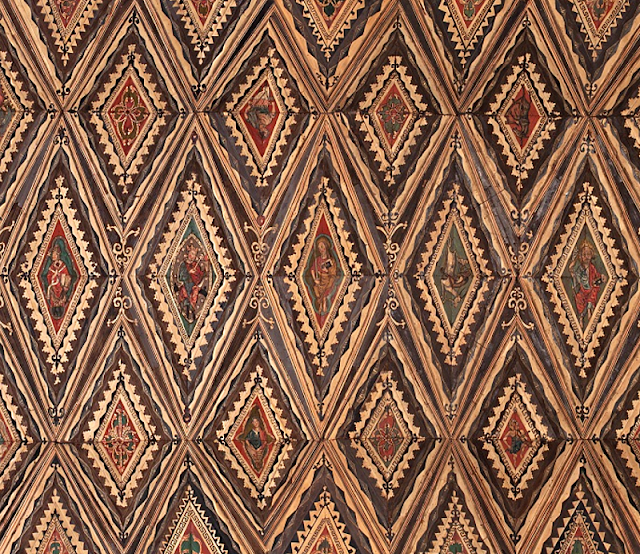A fine Norman gateway leads to an architectural gem.
Peterborough
Cathedral is one of the finest Norman cathedrals in England. Founded as
a monastic community in 654 AD, it was to become one of the most significant
medieval abbeys in the country, the burial place of two queens and the
scene of Civil War upheavals. The catheral has a really dramatic West Front exterior, an extraordinary creation of medieval architecture. It would be easy for the interior to be an anticlimax, but it is not.
The dramatic Romanesque interior is little altered since its completion, but arguably the painted wooden nave ceiling is the jewel in the crown being the only one of its type surviving in Britain. It is the largest of only four wooden ceilings still in existence from the same period in the whole of Europe. It is known from dendrochronology that the construction of the ceiling took place in the late 1230s and 1240s.
The clock without a face
The monks of Peterborough Abbey had to keep track of time in order to observe the eight daily services set by the Rule of St Benedict. For centuries they did this with the help of sundials and by ringing bells. Timekeeping was helped with this early clock. It has no face, but strikes every half hour so that the monks knew when to pray.
The wooden frame and earliest parts of the mechanism date from 1450 and are painted black. In 1687 local clockmaker John Watts added a more accurate pendulum and other parts (painted green). In 1836 a new mechanism (painted blue) was installed on top of the frame with a three-meter pendulum. This clock was in use in the bell tower until 1950 when it was replaced by an electronic device. It was restored and relocated within the cathedral in 1984, but it still works.

Katharine of Aragon's tomb
The pomegranates are left by well wishes sometimes tied up with scarlet and gold ribbon, colours which represent the Spainish flag. Ever since her early childhood, Katherine wore a pomegranate brooch, and as Queen she had a pomegranate emblazoned on her shield.
Robert Scarlett, known locally as 'Old Scarlett" was born in 1496 and died on the 2nd July 1594 at the remarkable age of 98. His life spanned the reigns of Henry V11, Henry V111, Edward V1, Mary 1 and Elizabeth 1. His longevity is thought to be due to his physical fitness as, even into his eighties, he was still digging graves in Peterborough. He has the distinction of having interred two queens in the Peterborough Cathedral - Katherine of Aragon and Mary Queen of Scots, and after he buried his first wife Margaret he claimed he had buried three queens! Scarlett then went on to marry his second wife, Maud, by this time well into his eighties.
These are just a few of the treasures that took my interest.
လလလလလလလလလလလလလလ
Since I have been away, I have been unable to comment on any blogs or reply to comments on my own blog. I have tried everything I can to rectify the situation but all to no avail. If anyone is able to help I would really appreciate it.
* I have just discovered that if I use a different browser I am able to comment*
.jpg)
.jpg)
.jpg)









.png)
.jpg)







.jpg)



